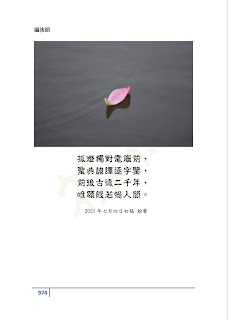2021年7月6日 星期二
2021年3月13日 星期六
關於「般若佛母」的翻譯
梵文與拉丁文、西班牙文、或德文相同,單字有陽、陰、中性之分;pāramitā 波羅蜜多為陰性,故有E. Conze 英譯金剛經加譯修飾為 the lovely 或Colgate College 的 the beautiful 美者之譯,用以表現般若為陰性詞。但是根據《大智度論》卷18:
「諸佛及菩薩,能利益一切,般若為之母,能出生養育。佛為眾生父,般若能生佛,是則為一切,眾生之祖母。」(大正25,190b28-c2)
又《大智度論》卷34:
「復次,般若波羅蜜是諸佛母,父母之中母功最重,是故佛以般若為母。」
(大正25,314a21-23)
般若智慧為諸佛之所出,故有云『般若佛母』。因此認為翻譯時若一定要強調 pāramitā 為陰性詞,個人以為用『母』字更能表現般若一詞為陰性的特質,而非加一個 the Lovely或the Beautiful以美麗表顯陰性之特質。
考諸佛經的經名有含「佛母」者,如。《佛母寶德藏般若波羅蜜經》梵文經典名為《prajñāpāramitā ratnaguṇasaṃcaya gāthā》並無「佛母」二字,但是本經(偈)每一品最後一行標名品名時卻都有bhagavatyāṃ 一詞,也就是「佛母」的翻譯。這或許也是十世紀末法賢譯師如此翻譯的因緣,如:
第一品:bhagavatyāṃ ratnaguṇasaṃcayagāthāyāṃ sarvākārajñatācaryāparivarto nāma prathamaḥ ||
第二品:bhagavatyāṃ ratnaguṇasaṃcayagāthāyāṃ śakraparivarto nāma dvitīyaḥ ||
根據 Sanskritdictionary.com 的解釋:f. bhagavatī- m. plural bhagavantaḥ-; or in Nominal verb with 3. sg. of the verb; with Buddhists often prefixed to the titles of their sacred writings (佛教聖典常加此詞),根據漢譯諸譯 (見《金剛經‧詮解篇》)比較,筆者大膽假設這應是出於中、後期或密教興起以後的經典才有的特徵。
2021年3月10日 星期三
Pronunciation of ॐ, OM 唵、嗡 or AUM
How the Sanskrit sign ॐ should be pronounced?
ॐ is used frequently in meditation or in dharani, which is a sign of combination of three Sanskrit letters, आ A, उ U, and म M. Therefore, by nature, it pronounces as A-U-M. However, it’s been translated into Chinese character as 唵 or 嗡,and pronounces as ‘Om’. Until recent years, some teaching videos on the internet show that the sign ॐ pronounced as ‘A-U-M’ instead of ‘OM‘. Even some yogis teach the sign be pronounced as ‘A-U-M’ not ‘OM‘.
I’m glad to find the comment made by Sautrik Bhattacharya on YouTube shown as below, which I think has the most reasonable explanation. It makes ‘grammatical’ sense at least!
“…you are right. They are three sounds a, u, m but when they are pronounced together then a+u becomes o according to the rules of sandhi of Sanskrit grammar which deals with the mixing of different sounds. It comes under guna svara sandhi. Like hita + upahaar = hitopahaar, gyan + upahaar = gyanopahaar. The rules are based on universal law of flow of words. So Om is the correct pronunciation.”
2021年3月4日 星期四
入不二法門 Entering of the Non-Dualistic Dharma Gate
vimalakīrtinirdeśa
—advayadharmamukhapraveśaparivarto:
. advaya :(अद्वय) refers to “non-duality”, According to Vajrayāna or Tibetan Buddhism.—The Bodhi mind (bodhicitta) is of the nature of Śūnya and the deity is a manifestation of Śūnya and, therefore, both have the same origin. But to realise that the two are the same requires perfect knowledge. Continuous meditation and austerities enable the worshipper to shed the veil of ignorance which makes one thing appear as two. The Bodhi mind is further called Karuṇā (compassion) and the ultimate reality as Śūnyatā, and when the two commingle, it is called Advaya or non-duality. 不二
. dharma: 法
. mukha: (मुख) n. mouth, face, entrance, opening, front. 門
. praveśa: m. entering, entrance, penetration or intrusion into 入
. parivarto, parivarta: m. revolving, revolution (of a planet etc.) 轉;noun m. a chapter 章/品 (Monier-Williams, Sir M. (1988))
—’ṣṭamaḥ = aṣṭamaḥ: the eight, 第八
-.-.-.-.-.-.
注:梵文文本第三品品名為 śrāvakabodhisatvavisarjanapraśno nāma tṛtīyaḥ parivartaḥ 弟子菩薩棄答品第三;而三本漢譯本和英譯本皆將此第三品分為<弟子品第三>(梵文本§1-§48, 英譯本 “ 3. The Disciples Reluctance to Visit Vimalakīrti”)、<菩薩品第四>(梵文本§49-78, 英譯本”4. The Reluctance of the Bodhisattvas“),所以第四品之後梵文文本與其他譯本品數少一。
一śrāvakabodhisatvavisarjanapraśno:
. śrāvaka: m. a disciple of the Buddha 聲聞、佛弟子
. bodhisatva: m. “one whose essence is perfect knowledge”, one who is on the way to the attainment of perfect knowledge. 菩薩
. visarjana: n. answering a question; abandoning, cessation 答、棄、中斷
. praśno, praśna: m. a subject of inquiry, point at issue, controversy, problem, etc.問題、答辯、爭論
一nāma: ind. by name, named, called 名
一tṛtīyaḥ: n. the third 第三
一parivartaḥ: ditto
What is nibbida? 厭離? 嫌膩?
Nibbida的英譯為“utter disgust”, or “disenchanted”, or “in revulsion toward 強烈的反感;厭惡;憎惡”, or “turn away from”? 或漢譯為「厭離」都各有討論。
「嫌膩」或是「厭離」nibbida 漢譯另一選擇。
英譯討論:https://www.lionsroar.com/dharma-dictionary-nibbida/
漢譯討論:https://www.facebook.com/groups/491306231038114/permalink/1773202419515149/













